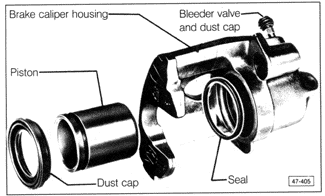5.2 CalipersFig. 5-8 is an exploded view of the front disc brake caliper. The piston seal holds the hydraulic pressure in the system as the piston moves, and also provides the caliper's self-adjusting action.

The caliper is self-adjusting. When the piston moves and presses on the brake pads, the seal is distorted slightly. When the pressure is removed, the seal pulls the piston back slightly, creating a small gap to minimize brake pad wear. As the pads wear, the seal is repositioned on the piston, so that the gap remains approximately the same. Brake fluid leaks around the brake caliper piston are the result of a failed or damaged piston seal, perhaps caused by corrosion, scoring, or pitting of the piston or caliper bore. The seal can be replaced, but a damaged piston, which is not available as a replacement part, will promptly destroy the new seal. Complete replacement of the caliper is recommended to remedy a leaking caliper piston seal and avoid future problems. A damaged caliper dust seal can be replaced separately. Remove front brake calipers as described in Removing and Installing Brake Pads. Disconnect the brake hose from the caliper and drain the brake fluid into a container. Cap the end of the brake line to prevent dirt and moisture from entering the brake system. Installation is the reverse of removal. Torque the brake hose union to 15 Nm (11 ft. lb.). Bleed the brake system as described in 4.2 Bleeding Brakes. and 4.3 Bleeding Brakes (ABS only). Do not let brake fluid contaminate the brake pads or brake rotor surface. |